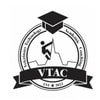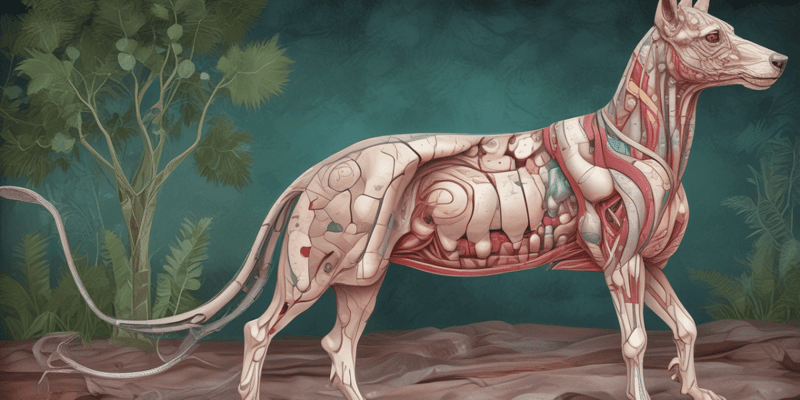Questions and Answers
What is a crucial aspect of comforting animals during stressful situations?
Using soothing voices, touching, or offering treats
Why is blood sampling important in veterinary care?
To diagnose diseases and check animal health
What is a key responsibility of veterinary assistants in wound care?
Cleaning, dressing, and bandaging wounds
Why is effective communication important in veterinary office management?
Signup and view all the answers
What role do veterinary assistants play in managing the veterinary office?
Signup and view all the answers
Why is skilled animal handling crucial for veterinary assistants?
Signup and view all the answers
What is one of the essential animal handling techniques mentioned in the text?
Signup and view all the answers
Why is learning restraint techniques crucial for veterinary assistants?
Signup and view all the answers
In the context of animal handling, what does a dog's tail wagging typically indicate?
Signup and view all the answers
What is the primary focus of veterinary assistants in terms of animal handling techniques?
Signup and view all the answers
Study Notes
Veterinary Science: Preparatory Training for the Veterinary Assistant
Introduction
The veterinary industry demands skilled professionals who can work alongside veterinarians and technicians to provide the best possible care for animals. One crucial role in this setting is the veterinary assistant, who plays a significant part in ensuring smooth operations, animal handling, and basic medical procedures. In this article, we'll delve into the topics of animal handling techniques, basic medical procedures for animals, and veterinary office management to provide an overview of the preparatory training for veterinary assistants.
Animal Handling Techniques
Skilled animal handling is a critical aspect of veterinary care, and it's the foundation of a veterinary assistant's work. Proper handling techniques help ensure the safety of both the animal and the assistant, as well as reducing stress for the animal. Some essential handling techniques include:
-
Restraint techniques: Restraining animals to perform examinations, vaccinations, or other treatments is a vital skill. Assistants need to learn how to safely restrain different types of animals using techniques such as scruffing, wrapping, and muzzling.
-
Body language: Understanding animal body language helps in predicting their behavior and responding appropriately. For instance, a dog's tail wagging can indicate happiness, whereas a low tail or tucked ears suggest they may be stressed.
-
Comforting animals: Assistants should learn how to comfort animals during stressful situations, such as using soothing voices, touching, or offering treats.
-
Grooming: Assistants need to learn how to groom animals to eliminate mats, dirt, and dead hair. Grooming techniques can also help detect any skin issues or diseases.
Fact: Veterinary technicians and veterinarians credit the work of assistants for the smooth execution of various procedures, as stated in the standing joke: "Veterinary technicians and veterinarians are only as good as the person restraining the animal" (Veterinary Practice News, 2016).
Basic Medical Procedures for Animals
Veterinary assistants often help with basic medical procedures, such as:
-
Administration of medication: Assistants should understand how to administer oral, topical, or injectable medications to animals, following their veterinarian's instructions.
-
Blood sampling: Assistants can help collect blood samples, which are crucial for diagnosing diseases and checking the health of animals. They should understand blood collection techniques, such as venipuncture, capillary sampling, and venous sampling.
-
Anesthesia monitoring: Assistants should learn how to monitor animals under anesthesia, ensuring that their vital signs remain stable and that they recover smoothly from anesthesia.
-
Wound care: Assistants should be familiar with wound cleaning, dressing, and bandaging techniques to keep wounds clean and promote healing.
Fact: Becoming a veterinary technician requires a combination of education, training, and experience. Assistants play a vital role in supporting these professionals, as they go through their daily routine of providing animal care (Veterinary Technician, 2013).
Veterinary Office Management
Veterinary assistants often play a role in managing the veterinary office, which includes:
-
Client services: Assistants should be able to greet clients, process payments, and answer general inquiries about veterinary care.
-
Inventory management: Assistants should be able to manage stock levels and reorder supplies as needed.
-
Scheduling: Assistants should be able to help schedule appointments and manage the veterinarian's calendar.
-
Communication: Assistants should be able to communicate effectively with veterinarians, technicians, and clients to ensure everyone is on the same page.
-
Record keeping: Assistants should be able to maintain accurate records of animal care, including medical histories, vaccinations, and treatments.
Fact: Veterinary assistants play an essential role in supporting the veterinarian and their team, as noted in a study which found that the lowest economic cost per veterinarian is among equine practitioners, while the highest is among food animal practitioners (NCBI, 2022).
In conclusion, veterinary assistants play an essential role in the veterinary industry, performing tasks that range from animal handling and basic medical procedures to coordinating office management. They contribute to the smooth operation of veterinary practices, helping to ensure the health and wellbeing of our animal companions. As the profession grows and evolves, so too do the opportunities for veterinary assistants to learn, develop, and advance their careers.
Studying That Suits You
Use AI to generate personalized quizzes and flashcards to suit your learning preferences.
Description
Explore the fundamental skills and responsibilities of veterinary assistants, including animal handling techniques, basic medical procedures for animals, and veterinary office management. Enhance your knowledge of the key tasks performed by veterinary assistants to support veterinarians and ensure the well-being of animals in a veterinary practice.





